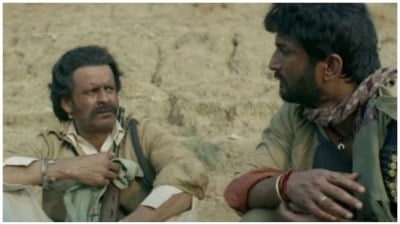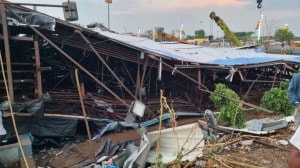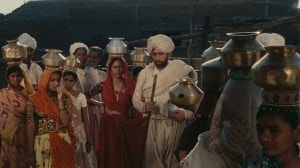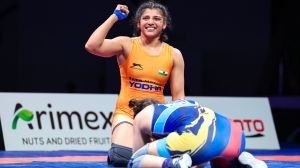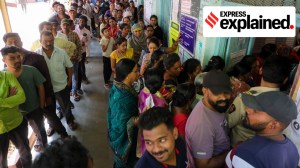- India
- International
Srinagar, Jammu and a study in contrast: 3 years on, how well did J&K DDCs fare?
Both Jammu and Kashmir divisions have 10 DDCs each, comprising 14 members including the chairperson and vice-chairperson.
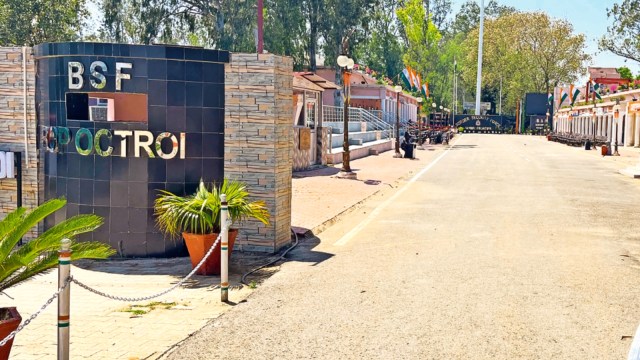 Amid increased footfall, BSF is holding the retreat ceremony at the Octroi Post along the IB in Suchetgarh four days a week. (Arun Sharma)
Amid increased footfall, BSF is holding the retreat ceremony at the Octroi Post along the IB in Suchetgarh four days a week. (Arun Sharma)The contrast couldn’t be more stark. Over three years since the formation of District Development Councils — envisioned as a third tier of governance in Jammu and Kashmir following the abrogation of Article 370 — their representatives have excelled in Jammu just as much as they’ve been held back in Srinagar.
Both Jammu and Kashmir divisions have 10 DDCs each, comprising 14 members including the chairperson and vice-chairperson. Each DDC is allocated
Rs 10 crore from the Union Territory’s budget every year, meant to be split equally between the 14 members. DDC members are supposed to use this Rs 71.42 lakh to propose public work in their constituency.
The maiden DDC elections were held in the last quarter of Srinagar, Jammu and a study in contrast: Three years on, how well did the ‘third tier of governance’ in J&K fare?
2020 to give the state a three-tier Panchayati Raj system.
The Indian Express looked at the performance of two DDCs – in Jammu and Srinagar — and found success stories in one case, and struggles in the other.

Srinagar
As part of the Smart City Mission, Srinagar saw a number of transformative projects – from roads to markets and sprucing up of public spaces. However, areas on the periphery of J&K summer capital are still struggling to keep up with the urban centre. Outside the municipal limits of the city, the rural constituencies are governed by the DDC, currently in the third year of its first-ever term.
The council took shape in January 2021 and since then, its 14 members have met only once. Chairman Malik Aftab was elected as its head, with 10 of the 14 votes helping the J&K Apni Party (JKAP) take control of the Srinagar council.
Members of the council who spoke to The Indian Express said that while they have individually pushed projects in their own constituencies, the council itself has failed to work as a cohesive unit. In the three and a half years since the members took oath, the standing committees meant to streamline the functioning of the council – finance, development, public works, health & education and welfare – have not been constituted. Aftab did not respond to requests for a comment.
Ali Mohammad Rather, an independent member of the council, said, “We have had no meetings since the first, where we elected chairman and vice-chairman. We are working as much as we can on our own, and through individual efforts, we are pushing public works such as roads and drainage repair in our respective areas.”
In the last three years, the members have moved a no-confidence motion against the chairperson and the vice-chairman Bilal Ahmad Bhat (JKAP) at least three times, but council meetings have still not taken place.
The DDCs were supposed to have their own offices, but as of today, the Srinagar council has been functioning out of the revenue department offices in Harwan.
Each year, members prepare plans depending on the needs of the constituency and funds are directed for these projects through the finance department. There is no fund directly available to the council members, and their mandate is to plan and monitor works. Each council member has a salary of Rs 15,000 a month, which they have repeatedly told the administration is not enough as a public representative.
Manzoor Ahmad Bhat, another member of the council from the Congress, said that the amount that can be pushed on the ground is solely dependent on the efforts of the member. “I have a car and I am able to head out to the District Collector’s office or the offices of various line departments, so I am able to put some pressure for work to be done as per deadline, or to avoid lapsing of funds,” he said. For this, he says, the Rs 15,000 remuneration is barely enough.
The council’s inability to sit together is, as per him, a hurdle in pushing bigger projects. “If there was a meeting and the chairperson would come, the officials of various departments would also be forced to come to those meetings and things would move faster. Since that is not the case, I have to run around to each department head and that is a difficult task,” he said.
In his area, Khonmoh, he has been able to build roads and prioritise street lighting. “We have also installed transformers where they needed replacement,” he said.
Another member of the council from the JKAP, Afroza Bano, who had voted for Aftab to be elected chairman, rues the fact that she is unable to meet officers because the council does not convene. “We sometimes meet the DC in his office. Hum sirf apna kaam karwa paate hain (we are only able to get our own work done),” she said. Despite all efforts, she said that out of the limited funds available to her, Rs 30 lakh lapsed in the last financial year.
In the three financial years since 2021, out of the annual Rs 10 crore grant, the Srinagar council has spent Rs 6.83 crore, Rs 6.79 crore and Rs 7.15 crore respectively. While funds are lapsing in the crores each year, members say this is because each member is making individual efforts, and if the council put its weight behind bigger projects, funds would not lapse. “Sometimes a department such as the Roads and Buildings wants approvals from the chairman of the council, and that doesn’t happen,” another member said.
Afroza said that though, on the ground, people have an understanding of the role of council, what is lacking is the respect as an elected representative. The sentiment is echoed by Mohammad Shaban Chopan, “The biggest issue in my area is the availability of drinking water. For the last three years, I have been running from pillar to post to address this but the reality is that when we go to an office to get work done, we are treated like peons.”
He adds that regular council meetings would have brought accountability to the system and brought more legitimacy to the DDCs.
Jammu
With blacktopped roads along the barbed wire fence near the Zero Line with Pakistan, a new theme – Gaon Se Khet Tak (from village to the fields) – is playing out among 21 panchayats in Suchetgarh sector along the international border in Jammu and Kashmir.
Today, most youngsters in villages here have at least a two-wheeler, which they use to travel to their fields, said Taranjit Singh Tony, a Congress leader and a member of the Jammu District Development Council responsible for Suchetgarh.
These roads, built over the past three years, are just one of many changes pushed through by DDC members in Jammu.
For instance, Sai village, spread over three panchayats with nearly 25,000 people, did not have a preschool for toddlers. Now, an air-conditioned facility is nearing completion within the premises of the Government High School, at a cost of Rs 20-25 lakh.
There have also been attempts to set up Suchetgarh as a tourist destination, with one of Asia’s largest horticulture nurseries spread over 100 acres near the international border at Chakroi one of the many attractions.
But a special emphasis has been on roads and connectivity. For instance, Rs 2.5 crore was spent to fix a bridge connecting Sai Tangali and Mule Chak villages, while Vidipur and Laiyan villages were linked by paving a two-kilometre road just last month.
R S Pura, J&K’s first planned town which boasts of a pond, elephant training centre, and a palatial temple, named after Dogra ruler Maharaja Ranbir Singh, is a sub-division headquarter in Jammu district. But while the roads here are double-lane, the ones in Suchetgarh are four-lane.
“Can’t one land an aeroplane here,” Tony asks with pride.
Such has been the tourist influx that a Retreat Ceremony – akin to the one held on the Wagah-Attari border near Amritsar – was inaugurated by Lt Governor Manoj Sinha at the BSF’s Octroi border post here on October 2, 2021. And from being held twice a week, it has now been extended to four days, a BSF official said.
This has also meant a boost to the local economy.
Anish Avasthi, who has studied till class 12 and started a restaurant a year ago, now employs three people. He says between 5,000 and 6,000 tourists visit the outpost to witness the ceremony.
Some villagers have come up with unique ideas like getting visitors to pluck vegetables that are then cooked for them.
Vijay Angurana, in-charge of the government-run Mega Fruit Plant Nursery at Chakroi, said work on it was started in September 2021 and completed in January 2023. “We bought litchi from Muzaffarabad, guava and mango from Lucknow, citrus fruit plants and peach plum from Ludhiana’s Punjab Agriculture University, besides dragon fruit plants from a certified nursery in Jammu. We now sell the saplings at government-approved rates to farmers and other people who want to set up their own orchards,” he said.
Except for Tony, who got elected from Suchetgarh as an independent and later joined the Congress, and National Conference’s Shamim Begum from Nagrota, the 12 other members in the Jammu DDU are from the BJP.
As these are the maiden DDCs, the UT administration has been organising workshops and tours for its members to other parts of the country for capacity building. “In January last year, we went on a 10-day tour of Bengaluru, Mumbai, Pune, Hyderabad and Mussoorie, which have a well established panchayati raj system,” said Suraj Singh, vice-chairperson of the Jammu DDC, who has been elected from Khour.
According to the Chief Planning Officer in the office of Jammu Deputy Commissioner Uttam Singh, Jammu DDC members have submitted proposals for 882 works worth Rs 30 crore since 2021-22. Of these, 765 works have been completed at the cost of Rs 19.63 crore. The remaining 117 works worth Rs 10.37 crore are under progress, he said, adding that many of them are nearing completion.
Works proposed by DDC members include construction of lanes and drains, setting up of open gyms, construction of classrooms, development and repair of school buildings and parks, and upgradation of health infrastructure at primary health centres and dispensaries.
With no assembly elections since 2019, these DDC members also liaison with government departments such as PWD, Jal Shakti, Power Development and Revenue to push bigger projects like bridges, tubewells, etc under NABARD, Jal Jeevan Mission and PM Awas Yojna.
Tony claimed that in the last three years, he got four bridges sanctioned from the government in his constituency, besides am 11-kilometre double-lane road from Dongri to Balli, almost 30 tubewells, and financial aid for at least 700 below poverty line families for construction of pucca houses.
In Bishnah, DDC member Dharminder Kumar too claimed to have brought in various big ticket projects such as roads and bridges.
The DDC members here say none of their proposals have been rejected by the government so far. “There is no chance of rejection if your proposal is for the good of the public and the file is complete,” said Tony, recalling how L-G Manoj Sinha has been encouraging him to submit proposals despite him being an opposition leader.
May 13: Latest News
- 01
- 02
- 03
- 04
- 05


